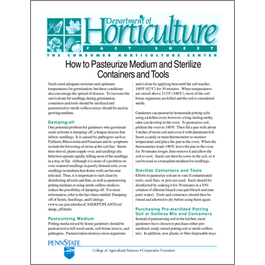PJ Diaz
Well-Known Member
Dude, did you read the first line of what you quoted there??:This is from Penn State University Extension Service:

How to Pasteurize Medium and Sterilize Containers and Tools
To increase the survival rate for seedlings during germination, containers and tools should be sterilized and pasteurized or sterile soilless mixes should be used as growing medium.extension.psu.edu
How to Pasteurize Medium and Sterilize Containers and Tools
To increase the survival rate for seedlings during germination, containers and tools should be sterilized and pasteurized or sterile soilless mixes should be used as growing medium.
Seeds need adequate moisture and optimum temperatures for germination, but these conditions also encourage the spread of disease. To increase the survival rate for seedlings during germination, containers and tools should be sterilized and pasteurized or sterile soilless mixes should be used as growing medium.
Damping-off
One potential problem for gardeners who germinate seeds at home is damping-off, a fungus disease that infects seedlings. It is caused by pathogens such as Pythium, Rhizoctonia and Fusarium and its symptoms include the browning of stems at the soil line. Stems then shrivel, plants topple over, and seedlings die. Infection spreads rapidly, killing most of the seedlings in a tray or flat. Although it is more of a problem on over-watered seedlings in poorly drained soils, even seedlings in medium that drains well can become infected. Thus, it is important to start clean by disinfecting all tools and flats, as well as pasteurizing potting medium or using sterile soilless media to reduce the possibility of damping-off. For more information, refer to the fact sheet entitled: Damping-off of Seeds, Seedlings, and Cuttings .
Pasteurizing Medium
Potting media mixed by home gardeners should be pasteurized to kill weed seeds, soil-borne insects, and pathogens. Pasteurization destroys most organisms and is done by applying heat until the soil reaches 180oF (82oC) for 30 minutes. When temperatures are raised above 212oF (100oC), most of the soil borne organisms are killed and the soil is considered sterile. Gardeners can pasteurize homemade potting soils using a kitchen oven; however, a long-lasting earthy odor can develop in the oven. To pasteurize soil, preheat the oven to 180oF. Then fill a pan with about 4 inches of moist soil and cover it with aluminum foil. Insert a candy or meat thermometer to monitor temperature and place the pan in the oven. When the thermometer reads 180oF, leave the pan in the oven for 30 minutes longer, then remove it and allow the soil to cool. Seeds can then be sown in the soil, or it can be used as a transplant medium for seedlings.
Sterilize Containers and Tools
Efforts to pasteurize soil are in vain if contaminated tools, seed flats, or pots are used. Each should be disinfected by soaking it for 30 minutes in a 10% solution of chlorine bleach (one part bleach and nine parts water). Tools and containers should then be rinsed and allowed to dry before using them again.
Pre-sterilized Potting Soil or Soilless Mix and Containers
Instead of pasteurizing soil in the kitchen, most gardeners have chosen to purchase either presterilized, ready-mixed potting soil or sterile soilless mix. In addition, new plastic or fiber disposable trays and sterilizing previously used containers.
Prepared by Phyllis Lamont, consumer horticulture center library coordinator, Kathleen M. Kelley, assistant professor of consumer horticulture and James C. Sellmer, associate professor of ornamental horticulture
My two cents: If you google search you will find plenty of commercial gardening operations that all pasteurize the soil. That's why I started doing it. I looked for potting soil that was already pasteurized, I couldn't find any on the market.
They don't seem to be worried about killing any beneficial microbes. Neither am I.
Incidentally, I am having the best results I've ever had, after pasteurizing the soil. But that's totally anecdotal.
"To increase the survival rate for seedlings during germination.."
Sure, for seedlings during germination if you are worried about damping off, go ahead and sterilize your media. Once you are past the seedling stage, you are harming your soil (assuming this is a soil-type grow) by pasteurizing it, and in turn doing your plants a disservice. Just grow in coco if you want a sterile media. Much of the nutrition is soil-type grows come directly from the microbes you are wanting to kill. It's literally their poop that is feeding your plants,.





